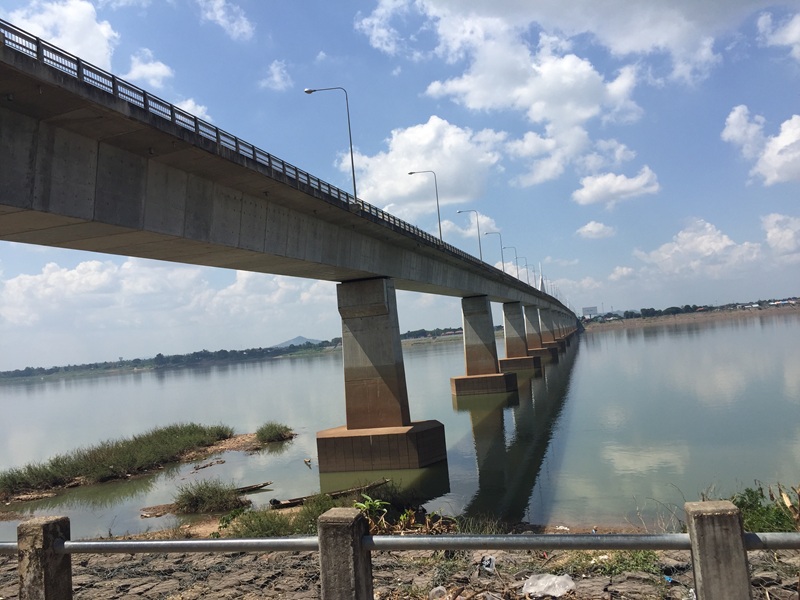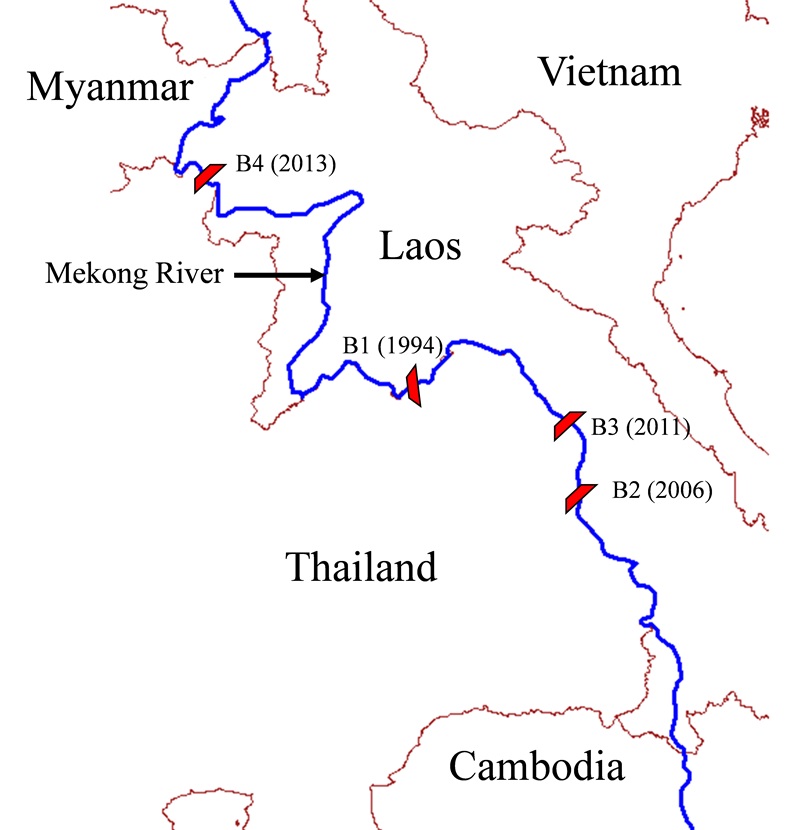IDE Research Columns
Column
Economic Impacts of International Bridges: Evidence from the Second Thai-Lao Friendship Bridge

Kazunobu HAYAKAWA
Bangkok Research Center, Institute of Developing Economies, Thailand
May 2025
The installation of international bridges helps reduce transportation costs for goods and people across countries. This column examines the economic impacts of international bridges between Laos and Thailand, with a particular focus on the second of the four constructed bridges. On the Thai side, the second bridge led to increased income for agricultural households located nearby, especially those owning agricultural land. It also raised wages more significantly for formal workers than informal workers in the surrounding areas. On the Lao side, the bridge reduced the share of household expenditure spent on food, suggesting improved living standards for households located close to the bridge.
International Bridges
The construction of international bridges reduces transportation costs for goods and people across countries. Numerous studies have examined the economic effects of changes in international trade costs resulting from trade policy (e.g., Han et al., 2016; Dai et al., 2021). However, international bridges differ from unilateral trade liberalization measures (e.g., reductions in most-favored-nation tariff rates) because they reduce trade costs in both directions. They also differ from the effects of trade agreements, as the effects of bridges are often unevenly distributed across regions within a country. Moreover, unlike tariff reductions, international bridges can substantially increase cross-border movement of people, thereby affecting the size of the labor supply and demand. In this article, we examine the economic impacts of international bridges between Laos and Thailand.
International Bridges between Laos and Thailand
As of 2025, there were four international bridges, commonly referred to as the Thai–Lao Mekong Friendship Bridges. Apart from a small portion of the national boundary, the two countries are separated by the Mekong River. The river reaches a maximum width of 14 km along the shared border. Therefore, international bridges play a vital role in facilitating the movement of goods and people between Laos and Thailand.
The first bridge was constructed with grant aid from the Australian government in 1994, connecting Nong Khai Province in northeastern Thailand with the Vientiane Capital of Laos. The second bridge, linking Mukdahan in northeastern Thailand with Savannakhet in central Laos, was completed on December 20, 2006, with regular services beginning in early 2007. The third bridge began regular service by the end of 2011, connecting Nakhon Phanom Province in northeastern Thailand with Khammouan Province in central Laos. The fourth bridge, between Chiang Rai Province in northern Thailand and Bokeo Province in northern Laos, was completed in June 2013. Figure 1 displays the relative locations of the bridges.

Figure 1. Four Thai–Lao–Mekong Friendship Bridges
Source: Created by Souknilanh Keola for this column.
Next, we briefly introduce studies that focused on the second bridge (B2 in the figure). This bridge was selected because detailed data around its establishment year were accessible to support empirical analysis. This bridge was financed by low-interest loans from the Government of Japan and constructed by the Japanese company, Sumitomo Mitsui Construction Co., Ltd. As part of the East–West Economic Corridor, the bridge was intended to connect Bangkok, the capital of Thailand, with Da Nang, the third-largest city in central Vietnam.
Economic Impacts of the Second Bridge
Three studies are presented here, covering the economic impacts of the selected bridge, which opened to vehicular traffic in January 2007. The first two studies examined effects on the Thai side. For example, Hayakawa et al. (2022) assessed the bridge’s impact on household incomes using 2005, 2006, 2010, and 2012 rounds of the Panel Household Socio-Economic Survey conducted by the National Statistical Office of Thailand. They found that the bridge increased the income of agricultural households near its location, particularly those owning agricultural land. The Thai end of the bridge in Mukdahan Province is recognized as an agricultural region. The share of the agricultural sector in the province’s economy rose from 20% in 2005 to 30% in 2011, which suggest that the bridge may have been partly responsible for boosting the agricultural activity in Mukdahan, and that households associated with the region’s comparative advantage (i.e., agriculture) benefited from the infrastructure investment.
The second study (Hayakawa et al., 2025) examined the bridge’s effects on the wage gap between formal and informal workers in Thai border regions using 2006 and 2011 Informal Employment Survey data, also conducted by the National Statistical Office of Thailand. The study found heterogeneous effects on wages, depending on employment formality in the goods and services sectors. Specifically, the bridge increased wages in both sectors, but to a greater extent for formal workers than informal ones within 100 km of the bridge. This widening of the wage gap may have resulted from rising formal wages caused by export growth, falling informal wages caused by the influx of Laotian informal workers, or a combination of both.
The third study, conducted by Andersson et al. (2025), analyzed the bridge’s impact on Laotian households using 2002 and 2007 rounds of the Lao Expenditure and Consumption Survey, conducted by the Department of Statistics in Laos. The authors examined changes in the share of food expenditure relative to total household expenditure. Using an econometric approach, the study found that proximity to the bridge reduced this share, suggesting improvements in household living standards. Additionally, a machine learning approach revealed that these benefits were greater for relatively wealthy households and those with younger household heads living near the bridge.
Conclusion
This brief summary of three studies highlights the positive effects of the second international Friendship Bridge built between Laos and Thailand (bridge B2 in Fig. 1) on nearby households. These studies are important and beneficial; however, further research is needed to better understand the underlying mechanisms driving the observed changes. In particular, the role of immigration warrants closer examination, as it represents a key distinction between the impacts of international bridges and those of tariff-related policies. Additional studies on international bridges in other country pairs would also be valuable. For example, the bridge of study connects a developing country to a least developed country (i.e., Thailand to Laos, respectively). The substantial wage differential between the nations clearly motivates Laotian workers to migrate to Thailand. Thus, immigration effects are likely to be especially strong in this context. Comparing with the case of two countries with a narrow wage gap would yield valuable insights.
References
Andersson, Magnus, Kazunobu Hayakawa, Keola Souknilanh, and Kenta Yamanouchi. 2025. “Impacts of International Transport Infrastructure: Evidence from Laos Households.” Journal of Asian Economics 97: 101876.
Dai, Mi, Wei Huang, and Yifan Zhang. 2021. “How Do Households Adjust to Trade Liberalization? Evidence from China's WTO Accession.” Journal of Development Economics 150: 102628.
Han, Jun, Runjuan Liu, Beyza Marchand, and Junsen Zhang. 2016. “Market Structure, Imperfect Tariff Pass-through, and Household Welfare in Urban China.” Journal of International Economics 100: 220-232.
Hayakawa, Kazunobu, Keola Souknilanh, Sasatra Sudsawasd, and Kenta Yamanouchi. 2022. “Impacts of an International Bridge on Households: Evidence from Thailand.” Journal of Asian Economics 83: 101536.
Hayakawa, Kazunobu, Keola Souknilanh, Sasatra Sudsawasd, and Kenta Yamanouchi. 2025. “International Bridges and Informal Employment.” Forthcoming in the Journal of Comparative Economics.
* Thumbnail image: The Second Thai-Lao Friendship Bridge ©YAMANOUCHI Kenta
** The views expressed in the columns are those of the author(s) and do not represent the views of IDE or the institutions to which the authors are attached.
©2025 Institute of Developing Economies (IDE-JETRO)

This column is licensed under a Creative Commons Attribution 4.0 International license (CC BY 4.0). https://creativecommons.org/licenses/by/4.0/deed

